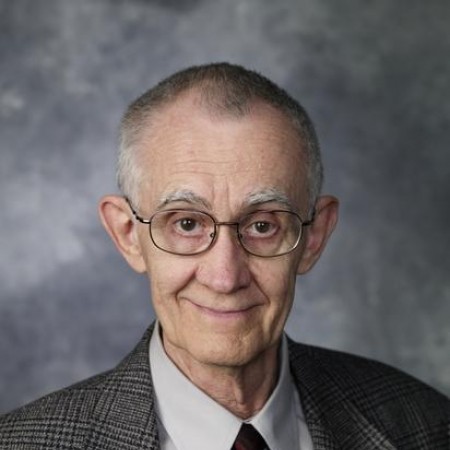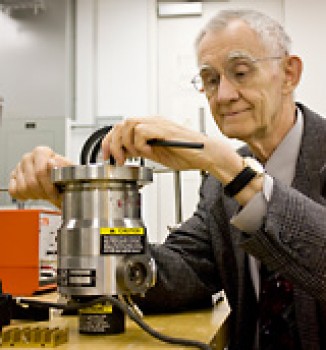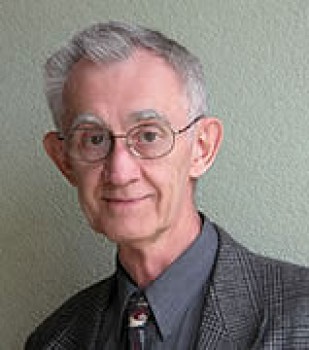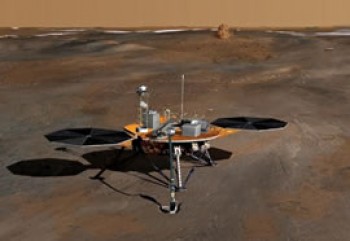Ph.D. - Physics
University of Minnesota - 1958

Professional Preparation
B.S. - Physics
St. Mary's College - 1954
St. Mary's College - 1954
M.S. - Physics
University of Minnesota - 1951
University of Minnesota - 1951
Research Areas
Overview
John Hoffman received his bachelor's degree from St. Mary's College in Winona Minnesota and continued his education at the University of Minnesota under the mentorship of Professor A. O. C. Nier who pioneered the field of mass spectroscopy. His PhD dissertation was on the helium isotopic distribution in large iron meteorites.He spent 7 years at the U. S. Naval Research Laboratory, Washington, D. C., developing miniaturized mass spectrometers for space flight. These were flown on Aerobee and Javelin rockets.
Dr. Hoffman joined the Graduate Research Center of the Southwest in 1966. His main interest was in the study of atmospheric/ionospheric composition and isotopic ratios for which he has developed instrument packages that have flown on many rockets and satellites. He developed instruments for the Apollos 15, 16, and 17 lunar missions, the latter being part of the ALSEP surface package. The goal was to detect and determine the composition of the lunar atmosphere. There is an atmosphere on the moon composed mainly of noble gases and hydrogen, but the pressure is lower than that in the best vacuum systems on earth.
His instrument flew on the Pioneer Venus mission to Venus in 1978. Data was received throughout the descent of the probe to the surface. Carbon dioxide is the dominant gas in the atmosphere. A surprise discovery showed that for the two "sister" planets there is a two order of magnitude difference in the isotopic ratios (the ratio of the heavier to lighter forms of these gases) for hydrogen and argon than for those gases on earth. These isotopic ratio differences have had large implications on models of the nature of the solar nebula and the formation of the present (secondary) atmospheres of the terrestrial planets.
Hoffman was a member of the team who flew a mass spectrometer on the European Space Agency's Giotto mission to Halley's Comet in 1986. This instrument was developed by laboratories in four countries, three European and at UT Dallas. It measured both the neutral and ionized constituents of the comet's coma. The coma contains, besides water vapor and H30 ions, an extended source of carbon monoxide. The atmosphere forms around a comet as it comes near the sun and is heated by radiation from the sun.
Hoffman has also flown mass spectrometers on earth orbiting satellites, Explorer 31, ISIS-II, AE-C, D, and E, and Wake Shield, plus numerous sounding rockets and stratospheric balloon flights. The first observations of the polar wind, ions flowing out from the atmosphere, were made by his ion mass spectrometer flown on the ISIS spacecraft in 1971.
Dr. Hoffman is a co-investigator for the TEGA experiment that flew on the Mars Scout Phoenix mission in 2007. The spacecraft landed in the far northern region of Mars, above the arctic circle in the area that the Mars Odyssey spacecraft has found evidence for water. An arm on the lander dug a trench a meter deep in the surface of Mars to look for water ice and other water related substances (minerals). These were scooped up and analyzed in a series of small furnaces. The effluents from the furnaces are being analyzed by the UT Dallas mass spectrometer to determine the presence of water and the mineralogical composition of soil samples. Isotopic ratios of the principal elements in the samples were determined and compared to the isotopic ratios of the atmospheric gases that are being measured by the mass spectrometer when it is not analyzing samples from the TEGA furnaces. Hoffmans instruments definitively confirmed the existence of water on Mars
Publications
Effect of Damping on Planar Spin-up Dynamics of Artificial Gravity-generating Tethered Satellite Systems. A. P. Mazzoleni, and J. H. Hoffman, 14th ASS/AIAA Space Flight Mechanics Conference, Maui, Hawaii, Feb. 2004. 2004 - Publication
Flexibility Effects on Non-Planar Spin-Up Dynamics of Artificial-Gravity-Generating Tethered Satellite System, A. P. Mazzoleni and J. H. Hoffman*, Proceedings of the 2003 AAS/AIAA Space Flight Mechanics Meeting, Ponce, Puerto Rico, February 9 - 13 (AAS Paper 03-219). 2003 - Publication
End-Body Dynamics of Artificial-Gravity-Generating Tethered Satellite System During Non-Planar Spin-Up with Elastic Effects Included, A. P. Mazzoleni, Proceedings of the 2003 AAS/AIAA Astrodynamics Conference, Big Sky, Montana, August 3 - August 7 (AAS Paper 03-537). 2003 - Publication
Advance of the Portable Magnetic Mass Spectrometer to Mass Spectrograph O. Victorova, V. Kogan and J. H. Hoffman, Fourth Workshop on Harsh Environment Mass Spectrometry., St. Pete Beach, FL. Oct. 7-10, 2003 2003 - Publication
Investigation of a Tethered Satellite System for Generation Artificial Gravity. J. H. Hoffman, A P. Mazzoleni, AIAA Joint Propulsion Conference, Huntsville, AL July,20-23, 2003 2003 - Publication
Attitude Dynamics of the End-Bodies of a Tethered Satellite System During Spin-Up, , A. P. Mazzoleni and J. H. Hoffman, Proceedings of the 2001 AAS/AIAA Astrodynamics Conference, Quebec City, July 30 - August , 2001, (AAS Paper 01-402). 2001 - Publication
Nonplanar Spin-Up Dynamics of the ASTOR Tethered Satellite System, J. H. Hoffman, A. P. Mazzoleni, Proceedings of the 2001 AAS/AIAA Santa Barbara, CA, February 11-15, 2001, (AAS Paper 01-193). 2001 - Publication
Design of a Momentum Exchange Tethered Satellite System, J.H. Hoffman, A. Mazzoleni, A. Santangelo, STAIF-2001 Conference, Albuquerque NM, February, 2001. 2001 - Publication
Appointments
Associate Dean for Undergraduate Education
The University of Texas at Dallas [2000–2009]
The University of Texas at Dallas [2000–2009]
Associate Dean
The University of Texas at Dallas [1989–1999]
The University of Texas at Dallas [1989–1999]
Professor
Dallas (UTD) [1978–Present]
Dallas (UTD) [1978–Present]
Head
The University of Texas at Dallas [1978–2001]
The University of Texas at Dallas [1978–2001]
Associate Professor
Southwest Center for Advanced Studies /The University of Texas at [1966–1978]
Southwest Center for Advanced Studies /The University of Texas at [1966–1978]
Staff Scientist
U.S. Naval Research Laboratory [1959–1966]
U.S. Naval Research Laboratory [1959–1966]
Research Associate
University of Minnesota [1958–1959]
University of Minnesota [1958–1959]
Research Assistant
University of Minnesota [1953–1958]
University of Minnesota [1953–1958]
Additional Information
Biographical Summary
J. H. Hoffman has had over 40 years experience in designing and producing miniature mass spectrometers for space missions to study Planetary atmospheres, particularly the composition of the neutral and ionic constituents.. Experiments have been developed and flown on Explorer 31, ISIS-II, AE-C, D, and E, Apollos 15, 16, and 17, ALSEP (LACE), Pioneer Venus Sounder Probe (LNMS), DE-1 (RIMS), GIOTTO (NMS), and Wake Shield, plus numerous sounding rockets and stratospheric balloon flights. The lunar instrument, in the Apollo 17 ALSEP, found the composition of the rarified lunar atmosphere to be mainly of noble gases and hydrogen. The Pioneer Venus instrument on the Pioneer Venus Multiprobe mission in 1978 confirmed that the atmosphere's principal constituent is C02, but that isotopic ratios of argon and hydrogen were two orders of magnitude different from earth.. These isotopic ratio variations between the two "sister" planets have had large implications on models of the nature of the solar nebula and the formation of the present (secondary) atmospheres of the terrestrial planets. The Giotto Probe to Halleys Comet in 1986, measured both the neutral and ionized constituents of the comet's coma. The coma contains, besides water vapor and H30 ions, an extended source of CO. The first observations of the polar wind, ions flowing out from the atmosphere, were made by his ion mass spectrometer flown on the ISIS spacecraft in 1971.Dr. Hoffman is a co-investigator an experiment called TEGA that will fly on the Mars Scout Phoenix mission in 2007. The spacecraft land in the far northern region of Mars, above the arctic circle in the area that the Mars Odyssey spacecraft has found evidence for water. An arm on the lander will dig a trench a meter deep in the surface of Mars to look for water ice and other water related substances (minerals). These will be scooped up and analyzed in a series of small furnaces. The effluents from the furnaces will be analyzed by the UTD mass spectrometer to determine the presence of water and the mineralogical composition of soil samples. Isotopic ratios of the principal elements in the samples will be determined and compared to the isotopic ratios of the atmospheric gases that will be measured by the mass spectrometer when it is not analyzing samples from the TEGA furnaces.
Dr. Hoffman was a co-investigator on another Mars Scout mission proposal. The NASA Langley Research Center is the prime organization heading a large team of scientists and engineers to develop an airplane to fly through the lower atmosphere of Mars to study the atmospheric and isotopic composition of the lower atmosphere, to look for sources of water and photolysis products from water, and to study the magnetic anomalies that have been observed on the Mars surface. Dr. Hoffman will supply the mass spectrometer as one of the prime instruments on board the airplane. The proposal is called ARES (Aerial Regional-scale Environmental Survey of Mars). It was submitted to NASA and was selected as one of 4 proposals for a Phase A study but not selected for flight.
Another of Dr. Hoffmans current research projects involves the design and construction of a tethered satellite called TAG. This project is supported by a grant from the Texas space Grant Consortium and a contract from the Texas Advanced Technology program. In 2002 he received a NASA STTR Phase I grant in conjunction with Orbital Technologies Corporation, Madison, WI, in support of this project. The objectives of the TAG (Tethered Artificial Gravity) mission are to study the operation and dynamics of an artificial-gravity-generating tethered satellite system and to provide a platform for high-school and college students to gain hands-on experience in planning, developing, constructing and flying a spacecraft that includes experiments of their own design. This flight is the first in a series to study tether flight dynamics and to develop the mechanisms for producing artificial gravity by spinning the two end masses separated by a tether of 2 km length around their center of gravity. Development of artificial gravity may be critical to planetary exploration by humans. The project is funded for continuation in a Phase II STTR project.
Professional Activities
- Member of Atmospheric Explorer Experimenters' Team 1970-1978
- Chairman of Pioneer Venus Atmospheric Composition Working Group 1978-1981
- Member of GIOTTO Neutral Mass Spectrometer Experimenters' Team 1982-1989
- Member of Board of Trustees, University Space Research Association, Washington, DC. 1988-1995
- UTD representative to USRA Council of Institutions 1988-2006
- Member, Steering Committee on Retraining High School Physics Teachers 1989-1991
- Chair, Texas Section of AAPT Pre-College Outstanding Teaching Award Committee 1988-1993
- Vice President, Texas Section of American Association of Physics Teachers 1990-1992
- President, Texas Section of American Association of Physics Teachers 1993-1995
- UTD representative to Texas Space Grant Consortium 1992-2006
Honors and Awards
- NASA Lunar Orbit Experiment Team Group Achievement Award, 1971
- UT Chancellor's Council Outstanding Teacher Award, 1988
News Articles
Profs Device Reveals More About Mars Atmosphere
 Instruments designed by a UT Dallas professor to measure atmospheric components on the surface of Mars have uncovered important clues about the planet’s atmosphere and climate history. The findings, published in a recent issue of the journal Science, reveal how carbon dioxide isotopes have reacted to volcanic activity, water and weathering – thus forming a more complete picture of the current Martian atmosphere. The NASA mission in which this work was accomplished was the Phoenix Lander, an unmanned spacecraft deployed to Mars in 2008. UT Dallas Physics Professor John Hoffman, a member of the William B. Hanson Center for Space Sciences, designed the mass spectrometer through which soil samples collected at the surface of Mars were analyzed.
Instruments designed by a UT Dallas professor to measure atmospheric components on the surface of Mars have uncovered important clues about the planet’s atmosphere and climate history. The findings, published in a recent issue of the journal Science, reveal how carbon dioxide isotopes have reacted to volcanic activity, water and weathering – thus forming a more complete picture of the current Martian atmosphere. The NASA mission in which this work was accomplished was the Phoenix Lander, an unmanned spacecraft deployed to Mars in 2008. UT Dallas Physics Professor John Hoffman, a member of the William B. Hanson Center for Space Sciences, designed the mass spectrometer through which soil samples collected at the surface of Mars were analyzed.
Prof Heads to Arizona to Monitor Mars Experiment
 Space scientist Dr. John H. Hoffman will join a team of researchers in Tucson, Ariz., on Sunday to watch the Phoenix Mars Lander touch down on the northern plains of the Red Planet after a 9-month-long journey from Earth. A physics professor and member of UT Dallas’ William B. Hanson Center for Space Sciences, Hoffman is part of a group led by Dr. Peter Smith of the University of Arizona in Tucson who were selected in 2003 by the National Aeronautics and Space Administration (NASA) to charter an unmanned mission to Mars. When it lands May 25, a 7-foot-long robotic arm on the solar-powered lander will dig a trench in the Martian surface to look for ice and other water-related substances. The materials will be collected and analyzed in a series of small furnaces, and the effluents from the furnaces will be analyzed by a mass spectrometer system designed by Hoffman. The system will determine the presence of water and the mineralogical composition of soil samples.
Space scientist Dr. John H. Hoffman will join a team of researchers in Tucson, Ariz., on Sunday to watch the Phoenix Mars Lander touch down on the northern plains of the Red Planet after a 9-month-long journey from Earth. A physics professor and member of UT Dallas’ William B. Hanson Center for Space Sciences, Hoffman is part of a group led by Dr. Peter Smith of the University of Arizona in Tucson who were selected in 2003 by the National Aeronautics and Space Administration (NASA) to charter an unmanned mission to Mars. When it lands May 25, a 7-foot-long robotic arm on the solar-powered lander will dig a trench in the Martian surface to look for ice and other water-related substances. The materials will be collected and analyzed in a series of small furnaces, and the effluents from the furnaces will be analyzed by a mass spectrometer system designed by Hoffman. The system will determine the presence of water and the mineralogical composition of soil samples.
Red Planet Mission: UT Dallas Professor Contributes to Exploration of Other Worlds
 Dr. John H. Hoffman, a space scientist at The University of Texas at Dallas, was on hand Saturday as the Delta II rocket carrying the Phoenix Mars lander lifted off from Cape Canaveral Air Force Base for a 10-month long journey to the Red Planet. A physics professor and member of the University’s William B. Hanson Center for Space Sciences, Hoffman is part of team of researchers lead by Dr. Peter Smith of the University of Arizona in Tucson who were selected in 2003 by the National Aeronautics and Space Administration (NASA) to lead an unmanned mission to Mars. The team, among other tasks, was asked to look for evidence of past habitability on Mars. Phoenix, laden with sensors, is expected to land on the northern plains of the planet in June 2008. Once there, an arm on the lander will dig a trench in the Martian surface to look for water ice and other water-related substances. The materials will be collected and analyzed in a series of small furnaces, and the effluents from the furnaces will be analyzed by a mass spectrometer system designed by Hoffman. The system will determine the presence of water and the mineralogical composition of soil samples.
Dr. John H. Hoffman, a space scientist at The University of Texas at Dallas, was on hand Saturday as the Delta II rocket carrying the Phoenix Mars lander lifted off from Cape Canaveral Air Force Base for a 10-month long journey to the Red Planet. A physics professor and member of the University’s William B. Hanson Center for Space Sciences, Hoffman is part of team of researchers lead by Dr. Peter Smith of the University of Arizona in Tucson who were selected in 2003 by the National Aeronautics and Space Administration (NASA) to lead an unmanned mission to Mars. The team, among other tasks, was asked to look for evidence of past habitability on Mars. Phoenix, laden with sensors, is expected to land on the northern plains of the planet in June 2008. Once there, an arm on the lander will dig a trench in the Martian surface to look for water ice and other water-related substances. The materials will be collected and analyzed in a series of small furnaces, and the effluents from the furnaces will be analyzed by a mass spectrometer system designed by Hoffman. The system will determine the presence of water and the mineralogical composition of soil samples.
Fresh From Mars: Scientist to Describe H20 Discovery
 Water on Mars? Scientists suspected the presence of H2O on the surface of our planetary next-door neighbor, but it took a series of tests and University of Texas at Dallas Professor John Hoffman’s instrument aboard NASA’s Phoenix Mars Lander to prove it. Hoffman will tell audiences at the Museum of Nature & Science at 1 p.m. and 3:30 p.m. on Aug. 30 how he and his team made one of this century’s first major space science discoveries. The finding prompted NASA to extend the Phoenix mission, which was set to wrap up this month, for another five weeks. Hoffman, a member of UT Dallas’ William B. Hanson Center for Space Sciences, designed the Thermal and Evolved Gas Analyzer (TEGA), a combination high-temperature furnace and mass spectrometer instrument that analyzed Martian ice and soil samples, the step needed to prove the existence of water. “If we could give Dr. Hoffman and his team a ticker-tape parade, we would,” said Steve Hinkley, director of education for the Museum of Nature & Science. “We are thrilled that he will spend a day with us to explain how one of the most persistent scientific questions of our time has been answered.”
Water on Mars? Scientists suspected the presence of H2O on the surface of our planetary next-door neighbor, but it took a series of tests and University of Texas at Dallas Professor John Hoffman’s instrument aboard NASA’s Phoenix Mars Lander to prove it. Hoffman will tell audiences at the Museum of Nature & Science at 1 p.m. and 3:30 p.m. on Aug. 30 how he and his team made one of this century’s first major space science discoveries. The finding prompted NASA to extend the Phoenix mission, which was set to wrap up this month, for another five weeks. Hoffman, a member of UT Dallas’ William B. Hanson Center for Space Sciences, designed the Thermal and Evolved Gas Analyzer (TEGA), a combination high-temperature furnace and mass spectrometer instrument that analyzed Martian ice and soil samples, the step needed to prove the existence of water. “If we could give Dr. Hoffman and his team a ticker-tape parade, we would,” said Steve Hinkley, director of education for the Museum of Nature & Science. “We are thrilled that he will spend a day with us to explain how one of the most persistent scientific questions of our time has been answered.”
Prof Plays Vital Role in Mars Water Breakthrough
 NASA’s Phoenix Mars Lander has recently confirmed what space scientists have suspected for a long time: There is water on Mars.UT Dallas Physics Professor John Hoffman, a member of the William B. Hanson Center for Space Sciences, is at the center of the discovery. Hoffman’s mass spectrometer is the system that analyzed gases from soil samples, the step needed to prove the existence of water. The Lander’s robotic arm has been digging in a number of places within reach of the stationary lander. The sites of interest have been given Disney character names, like “Mama Bear, Baby Bear, Goldilocks, and Snow White trench.” To make the analysis, soil samples from a trench 2 inches deep were heated in furnaces aboard the Phoenix Mars Lander. A number of measurements showed the presence of water in the sample as it was heated from -10 C up past the melting point of ice (0 degrees C).
NASA’s Phoenix Mars Lander has recently confirmed what space scientists have suspected for a long time: There is water on Mars.UT Dallas Physics Professor John Hoffman, a member of the William B. Hanson Center for Space Sciences, is at the center of the discovery. Hoffman’s mass spectrometer is the system that analyzed gases from soil samples, the step needed to prove the existence of water. The Lander’s robotic arm has been digging in a number of places within reach of the stationary lander. The sites of interest have been given Disney character names, like “Mama Bear, Baby Bear, Goldilocks, and Snow White trench.” To make the analysis, soil samples from a trench 2 inches deep were heated in furnaces aboard the Phoenix Mars Lander. A number of measurements showed the presence of water in the sample as it was heated from -10 C up past the melting point of ice (0 degrees C).